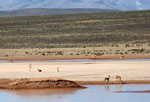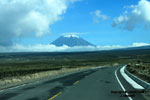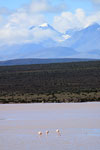Reserva Nacional Salinas y Aguada Blanca
Salinas and Aguada Blanca National
Reserve
Location: Department of Arequipa, provinces of Caylloma and Arequipa.
Area: 366,936 hectares.
Creation: August 1979.
35 Km / 22 miles northeast of Arequipa City (1 hour and 30 minutes by bus)
The reserve covers almost 366,936 hectares, including territory from the Provinces of Arequipa, Caylloma (department of Arequipa), and General Sánchez Cerro province (department of Moqueqa). It was created for the purpose of preserving important associations of flora and fauna, protecting the natural environment that was deteriorating and in the process of being destroyed, as well as caring for the vicuña through a repopulation program.
The reserve is located between 2,800 and 6,050 m.a.s.l. (9,186 and 19,849 f.a.s.l.) and the Misti (5,.825 m.a.s.l. / 19,111 f.a.s.l.), the Chachani (6,075 m.a.s.l. / 19,931 f.a.s.l.), and the Pichu-Pichu (5,664 m.a.s.l. / 18,583 f.a.s.l.) volcanoes are found there.
Among the most representative species of the reserve are the Southern Viscacha (Lagidium viscacia), the fox, the condor, and the Andean flamingo or parihuana. Scientists have determined the existence of 169 animal species, 23 of which are mammals (including two forms of domesticated South American camelids), 138 species of birds (blue billed ducks, eagles, and kestrels are the trophies), 3 reptilians, 4 amphibious, and 3 fish species. Salinas Lake is considered a special spot to observe flamingos during their migration period.
Aguada Blanca Dam is located behind Misti Volcano (according to the city of Arequipa), in an extensive plateau at 4,000 meters above sea level (13,123 feet). This dam forms a great artificial lake with the waters of Blanco River. Behind the Pichu Pichu Volcano also exists the Salinas Lagoon. Both are places where a great population of birds rest, among those one of the most important are the "parihuanas" flamingos (Phoeneicopterux tuber) keeping a close relation with the migration of the Reservation of the Mejía Lagoons.
Inside this reservation is located Pampa Cañahuas and Toqrapampa, almost behind the Chachani Volcano, where the tarucas (Hippocamelus antisiencis) are protected (tarucas are deers of a small size that are in a vulnerable situation). There are also great quantity of vicuñas in wildlife.
The vicuña (Vicugna vicugna) is a mammalian camalidae, that inhabits the high mountains of the Andes. It has 95 cm height and 55 kilos weight on the average, long neck and elegant figure. It is covered with a short frizzy wool (reddish wheat color) of extraordinary quality. It lives up to 15 years and can be tamed.
It was in extinction danger due to their merciless hunt. Their wool is the finest textile fiber in the world, very well appreciated in the international market. It is represented in the National Shield of Peru like the symbol of the wealth of the animal kingdom.
The road (34A - 1SE) between Arequipa and Colca Valley crosses this area, and you will be able to enjoy beautiful landscapes and to observe Andean camelids as vicuñas, alpacas and another species.
Photo Galleries
- Pampa Cañahuas in route to Colca Valley
- Salinas and Aguada Blanca
- Andean Birds in Bofedales Pampa Toqra - Salinas and Aguada Blanca N.R.
Salinas and Aguada Blanca Map
 AREQUIPA PHOTO GALLERY
AREQUIPA PHOTO GALLERY
- Casa del Moral
- Children of Colca
- Colca Canyon Landscapes
- Colca Valley Landscapes
- Colca Valley Landscapes 2
- Colonial Large Houses
- La Catedral (The Cathedral)
- La Compañía - Church
- La Compañía - Cloister
- La Mansión del Fundador






